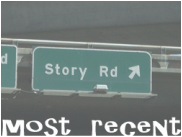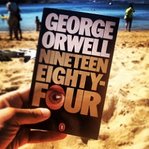| As any self-respecting, braille-literate, technologically savvy blind person will tell you, braille refreshes. As for me, I’m sighted and it certainly refreshed me when I was down and out and working a dead-end job in a Boston delicatessen and crying over my unfaithful college girlfriend who had no allegiances except to beauty in all its masculine forms. It was the late 1970s, before the invention of refreshable braille, before the passage of the ADA, before there was braille on signage and on elevators and on ATMs, and before there were ATMs. I had heard of braille, of course; I vaguely knew it was what blind people used for reading. I think I even knew that it was named after some blind guy from France. But I’d never actually seen it. In that sense, it was like many things in the world that I had heard of but never laid eyes on: enriched uranium, Timbuktu, quarks, baobabs, braille, etc. I was vegging out in my ground-floor apartment one mildewy fall afternoon with nothing to do and nada to smoke, looking around desultorily for an orphaned roach in the ashtrays, when I caught the unmistakable scent of cannabis coming from somewhere out in the hallway. I could hear a sort of clicking-sweeping-whacking sound interspersed with cries of merda and when I opened the door to my apartment, there was this blind guy with a joint in one hand and a stick in the other (I would later learn that the stick is properly called a cane) hopelessly lost in the infinity of the vestibule. |
| When I opened the vestibule door, he thanked me profusely and offered me the joint, which I sucked vigorously for ten or twenty seconds, then, with popping eyes and farting lips, tried to give back to him. But this was made complicated by the fact that he was blind. I held it out to him but he just stood there with his chin resting serenely on the handle of his white cane. “Beautiful day, isn’t it?” he said, as if he could see it--as if he could see the day. The joint he couldn’t see, that much was plain, because I was holding it up to him and waving it in front of his face, and when he didn’t reach for it I figured what the hell and I took a few more hits. Behind him, in the yard outside the vestibule, there was a maple tree with its pants down around its ankles, bare but for the red and orange leaves clinging to its lower branches and pooled on the ground all around it. “My name is Edgardo,” he said. “Do you live in this building?” His English had a charming tinge of foreignness about it, some faintly drum-rolled r’s, an occasional Portuguese diphthong. “Here ya go,” I said, having finally figured out that using my voice was the only way to get him to see that I was handing him back his joint. He immediately reached his hand out in the direction of my voice, and it felt a little like a moon landing or the delicate maneuvering of a cargo ship trying to attach to a dorsal port of the space station as my thumb and forefinger floated toward his thumb and forefinger in space and the handoff was accomplished, quite seamlessly actually. I was impressed. I was also already a little stoned. “Yes,” I said, pointing to my door, “I live right there. In 1A.” “Then we’re neighbors,” he concluded, smiling big, holding his hand out again, this time for me to shake it, “I’m in 3B.” I liked this guy. I was immediately attracted to him, not in a sexual way, but in a blind way, though I couldn’t have said what it was exactly, watching him puffing that joint with his eyes squinting slightly against the smoke, the two of us still standing there in that vestibule doorway with nothing between us but a diminishing roach and a long white cane that I felt a faint tug of desire to take from him, to hold in my own hands and try out myself, to share with him the way we were sharing his joint. Over the course of the next twelve months, Edgardo would share much with me. His cane, his elbow, some tips on sighted guide technique, his pot, his booze, and his braille Playboy. That Playboy, as a matter of fact, was the first braille I ever laid eyes on. It had the iconic rabbit-in-a-bowtie logo emblazoned in black ink on the front cover, and National Library Service for the Blind and Physically Handicapped printed in the bottom left-hand corner. I still remember the shock and the thrill of opening the magazine up to find that it was completely blank--a vast expanse of white goose bumps, a blizzard of snowy dots. I asked Edgardo, half jokingly, “Where are all the pictures?” as I turned the pages, wondering if the magazine was upside down or right side up. So many dots, each one casting a tiny shadow, like the view from an airplane flying over a country of igloos. “It doesn’t have any pictures,” said Edgardo, taking the magazine from my hands and closing it, then slipping his hand inside and reading it silently to himself. “But it has descriptions. And it has captions. And I have my imagination.” Then he began to read aloud: “Becky Dupree, Miss March, leans seductively against a door jamb of the barn, wearing a cowboy hat and a button-down cerulean shirt open to her navel…” “Does it really say that?” I asked him as he rolled his eyes and stuck out his tongue salaciously, his fingers rubbing the dots in an exaggerated, pornographic way. “Ooh, she IS hot! Take a look at this,” he said, handing me back the magazine, his index finger pointing to a row of dots halfway down the page, as indecipherable to me as a “You Are Here” sign in Mandarin. I was intrigued. So this was braille. But how on earth did it work, how were the letters represented, the punctuation, the paragraphs? Where was the alphabet in all this whiteout of dots? It was right then and there that I resolved to learn it, to teach myself braille, to see for myself if Becky Dupree was indeed wearing a cerulean shirt unbuttoned to her navel, to demystify this inscrutable code that most people, myself included, assumed was something that only the blind could apprehend. What did I have to lose? Braille was the most interesting, provocative, refreshing thing to cross my path since I’d broken up with my college girlfriend (see above) and run away to Boston. With nothing to claim my interest or attentions, why not give myself over to braille? “May I keep this?” I asked Edgardo, holding the braille Playboy to my chest in a protective, possessive attitude as though it were Becky Dupree herself. Luckily, Edgardo was willing to part with the magazine, seeing as it was the March issue and we were now in the middle of September. He was months behind in his reading, the braille Playboys and Reader’s Digests and National Geographics and Washington Post Book Worlds in piles all around his apartment, leaning towers of braille growing precariously toward the ceiling like stalagmites in a dark cave. The day after commandeering his Playboy, I signed up for a correspondence course in braille transcription with the Hadley School for the Blind in Winnetka, Illinois, and I spent the next twelve months learning the braille code. I kept Edgardo’s Playboy under my bed for that whole year, taking it out and dusting it off now and then to hunt for Becky Dupree, who, when I was finally fluent enough to find her, wasn’t even in there in the end. After I’d read the whole issue, front to back, I realized, a little too late, that Edgardo had invented her--he’d made her up just to get my goad. Or is it goat? I suppose it’s both: he got my goat--my randy inner goat--interested, and that’s what goaded me on to learn braille. Braille is dots in a cell. Lots and lots of cells. Each cell has six dots, like a prison cell with six beds in it, and the entire alphabet squeezed in, jockeying for position. Plus some 200 contractions, punctuation marks, and formatting signs. It can get very crowded in the braille cell, and many contractions take up two cells, and most configurations have their opposite, their mirror image, which is a different character with a different, unrelated meaning. Take, for example, the word “unbuttoned”. It has only one contraction, “ed”, which is the mirror image of the letter “n”, of which there are two in “unbuttoned”. There are also two “u”s and two “t”s. Some contiguous double letters can be contracted in braille, but not, alas, the two “t”s in “unbuttoned”. Nor the two “e”s in “Dupree”. Some contractions can stand alone and also within words, the way “butt” can stand alone and also within the word “unbuttoned,” though “butt” per se isn’t a contraction in braille. Though maybe it should be. Especially in the context of Becky Dupree. You could write to the Braille Authority of North America, I suppose, and propose that “butt” be added to the official list of braille contractions. But chances are, if they replied at all, they would reply that “butt” does not merit its own contraction in the braille code. They have no sense of humor, those Braille Authority of North America wonks. Braille takes up a lot of space. Harry Potter and the Half-Blood Prince, for example, is 8 volumes in braille. The King James version of the Bible, in braille, is 18 volumes. The American Heritage Dictionary is 72 braille volumes, and each volume is a huge cumbersome tome of some 250 braille pages. There is such a braille dictionary stacked like a cord of wood from floor to ceiling against the east wall of the proofreading department at the National Braille Press in Boston, where I ended up getting a job as a braille transcriber almost exactly one year after first laying eyes on Edgardo’s braille Playboy. All of the proofreaders at the National Braille Press are blind. They sit at their desks, reading all day in the shadow of the hulking 72-volume braille dictionary, looking for mistakes. Occasionally, one of them will stop reading, her fingers hovering over the hyphen in a hyphenated word coming at the end of a line. Then she’ll rise slowly and with arms outstretched, walk gingerly over toward the enormous dictionary and run her fingers along the spines of the volumes until she comes to the right volume that contains the word she’s looking for, to double-check its syllabification, to verify the correct placement of the hyphen. A hyphen in braille is two dots--dots 3 and 6--and you would think that finding a single hyphen in a 72-volume braille dictionary would be like finding a needle in a haystack, or a nipple in a snowstorm. But it’s not. In fact, a skilled blind proofreader can find it there with the tip of her index finger in less than a minute. And that, in a nutshell, is what I love about braille. |
| Paul Hostovsky makes his living in Boston as a sign language interpreter and Braille transcriber. His latest book, The Bad Guys, won the FutureCycle Poetry Book Prize for 2015. He has been featured on Poetry Daily, Verse Daily, NPR's The Writer's Almanac, and his work has won a Pushcart Prize and two Best of the Net awards. Visit him at www.paulhostovsky.com |











